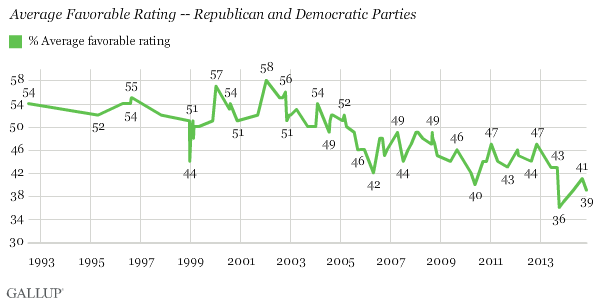Americans' two major political parties are falling into disfavor. Americans are more likely now than at any other time in recent history to avoid choosing either the Republican or the Democrat label when asked to identify their political identification, with 43% instead now choosing the label "independent." Additionally, as seen in the accompanying graph, the average favorable rating given to the two major parties has been dropping over time. The average favorable rating in the last couple of years is as low as we have seen it in our Gallup history. The average used to be routinely above the 50% mark. In our most recent November poll it was at 39%, the same as the average over our last three surveys going back to 2013.

Most obviously, these observable shifts reflect the basic fact that the government and Congress are in a very significant state of disrepute at the moment. We have reported much demonstration of this fact as it relates to the federal government, Congress and way government in general functions -- as I've discussed here in some detail. The plausible hypothesis is that this dislike of Washington and the federal government now extends to a dislike of the two major political parties that control Washington and the federal government. This dislike increases the probability that an American who is asked by an interviewer to label themselves politically will eschew the major parties and choose the label independent -- and decreases the probability that Americans will give either party a favorable rating.
The decrease in the percentage of Americans choosing to label themselves as Republicans and Democrats represents a shift in the public's presentation of self. This is potentially important. How an individual wants to present him or herself and how they want others to see them are significant social indicators and can also be significant correlates of behavior.
Several commentators have noted that this phenomenon doesn't necessarily mean that voters are more likely to "swing" between partisan candidates during the course of a campaign. That may be so; perhaps when there are only two major party candidates on a ballot, voters see little reason to switch or consider switching from one party's candidate they don't like to another party's candidate they don't like. Plus, we know that the majority of those who identify as independents indicate in response to further questioning that they lean toward one party or the other.
But there has clearly been a shift in the way Americans view the two major parties overall, and one possible implication of their increased disdain could be that Americans may become less interested in voting, given that most candidates on the ballot for national offices are running on one of the two major party tickets.
We did see a drop in turnout in the 2014 midterm elections, although it is impossible to determine exactly what caused that drop. Turnout in the 2012 presidential election was down from the 2004 and 2008 peaks, but no lower on a percentage basis than it has been in elections prior to that. However, if growing disenchantment with the two major parties and lack of viable alternatives to those parties on the ballot continue, it's possible that we could see turnout further decrease.
One might also hypothesize that there would be a growing appetite for third party or independent candidates going forward, although that obviously has not materialized to date. At this point there are no independents in the 435 member House, and two out of the 100 senators (Angus King of Maine and Bernie Sanders of Vermont) are nominally independents, although both caucus with the Democrats. At the presidential level, the last consequential third-party candidate was Ross Perot in 1992 and to a lesser degree in 1996.
Most generally, the data suggest that the two parties are weaker now than in the past as far as the perceptions of the average American are concerned, and therefore the two-party system is, in theory, subject to outside disruption and innovation -- although changes in the political system move glacially. It's hard to change the basics of the two-party system when the two major parties are in control of the system.
